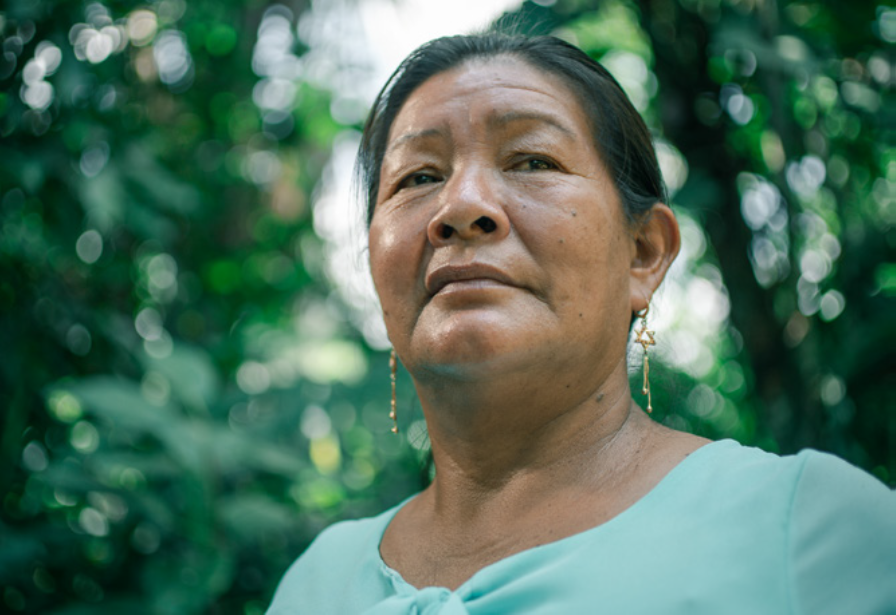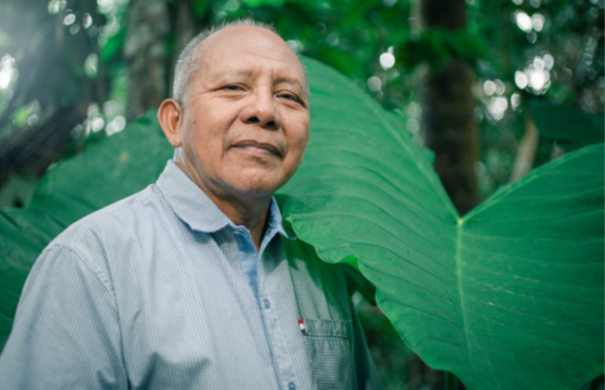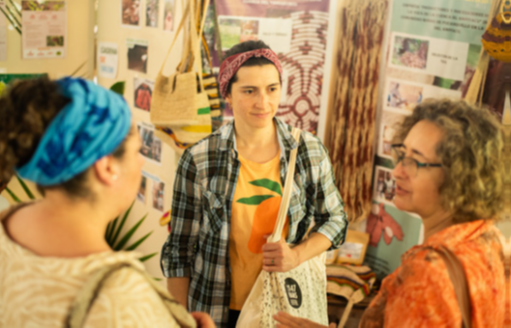The Green Livelihoods Alliance stands in solidarity with…
11 March, 2025
Wednesday 10 july 2024
At last year’s regional summit Conversations from the Amazon, representatives of Indigenous peoples gathered in Colombia to share knowledge and develop ‘sustainable initiatives of cultural and economic value’. Governments in the Amazon can set to work with them now, for the protection of the world’s richest rainforest. ‘You can cross the border in ten minutes, but sometimes it takes you years to complete a deal legally.’
This article originally appeared in a special issue of journalistic platform Vice Versa called “Listen, a new sound!” about the Power of Voices partnerships.
Text: Merel Rumping. Header photo: Felipe Rodriguez Vásquez
Together, the participants in the Conversations drew up a total of fifteen principles to define local economies that will have to ensure the well-being of the population and the territory. They are divided into four overarching categories: cultural principles, rights principles, biocultural and ecological principles, and social and organisational principles – and for each of them, one lesson is highlighted.
Juana Marín, in her early fifties and legal representative of the Barasana community in Colombia, grew up in the Amazon jungle, by the Pirá Paraná river. One thing is certain for her: within a future Amazon economy, her community’s traditions will be recognised.

‘My leadership is twofold: we not only protect the Amazon, but fight for our traditions, for the languages, dances, ceremonies, family relationships and forms of governance. The name of my community means “Mother Nature”.
‘With the support of NGOs – such as Gaia Amazonas, a partner of the Green Livelihoods Alliance – we support our people so they can fight for the preservation of the Amazon. Basically, each group of original inhabitants forms a link to communicate with the state. For 26 years, I have been engaging in discussions with anyone who does not take us into account.’
Alirio Lopez, territorial leader of the Indigenous group Uwottuja, has a friendly round face. He is a retired teacher of Spanish, English and Uwottuja and turns out to be a gifted speaker. ‘That is why,’ he adds, ‘we all learned to speak Spanish: every group in the Amazon speaks its own language, but we need Spanish to defend our territory.
‘Fifteen years ago, I was chosen by my community to do this work, but actually you are born with this title. To me, being a leader means fighting a spiritual and physical battle. Spiritual, as we join other original inhabitants in pursuing the same common goal.
‘At the same time, it is physical: we are constantly engaging in dialogue and turning ideas into documents to protect ourselves from parties that want to thwart us, or to connect with people who want to support us. We inform and motivate young people and we keep an eye on them to ensure that not everyone just joins and leaves our movement whenever they like.’
It soon becomes clear that an alternative economy is important not only for preservation of the rainforest, but also for its inhabitants. It safeguards their welfare and their collective right to territory while recognising their knowledge and practices as a legitimate way to contribute to the development of the region.
Lopez hesitates whether he wants his picture taken. ‘A year ago, a member of the Uwottuja was shot in the Amazon city of Puerto Ayacucho, in Venezuela,’ he says. ‘People from the outside’, as Lopez calls them, had set up a drugs lab, extracted gold from the mines and constructed an airstrip for transport within a unique, protected area of the rainforest.
‘That not only polluted the environment, but also endangered the community – we disagreed, so we decided to report it.’ The ‘outsiders’ found out who was behind it and killed Lopez’s colleague.
And then there is another risk, namely the extremely dangerous mining industry that represents a significant challenge to Venezuela. Every day, miners risk their lives because of explosion hazards, falling rocks and collapsing tunnels. Illegal mines are even more dangerous, any form of safety is hard to find there. The passages are sometimes so narrow that people get stuck.
‘In certain unique, forested areas in the Amazon,’ says Lopez, ‘mining is strictly prohibited. It is therefore absurd that the same government that bans mining allows certain groups to mine gold, tin and coltan in our territory. I call that paradoxical leadership. It has a disastrous impact not only on the environment, but also on our people who are forced to work in the mines in exchange for supplies and clothing.’
A new economy is only possible if the temptation of obtaining income from destructive illegal activities is resisted. The history of the Amazon is characterised by alleged economic *booms that have exploited the area’s natural resources.
Consider, for example, the extraction of quinine, rubber, the trade in animal furs and coca, and more recently the exploitation of hydrocarbons and minerals. These ‘bonanzas’ have led to the fragmentation and degradation of the Amazon, which is incompatible with the protection of life and biodiversity in a region that is crucial to the well-being of the planet.
The area is inhabited by 410 Indigenous groups, 82 of which live in voluntary isolation – and the very knowledge systems of those groups have maintained and nurtured diversity in all its manifestations. That is why it is so important to look for better ways to protect the Amazon, by listening to the people who have lived there for centuries.
But any economic alternative implemented in the Amazon must protect the forest and territories, because, according to Indigenous wisdom, they are intimately linked to each person’s life. Residents should therefore have the sovereignty to grow their own food to provide for their own well-being and have the opportunity to sell products based on their own food systems.
The community of Lopez started a cocoa business. Venezuelan cocoa is among the best in the world and is easy to grow, he says: ‘Fortunately, people see that it grows quickly and almost by itself, the jungle protects itself through these kinds of plants. Cocoa thus serves as a tool for climate control.
‘My community consists of 15,000 people who live in an area surrounded by four rivers, and about one in ten earns his or her living from cocoa production. We still lack knowledge in some fields, for example on pesticides – which is why technical guidance and knowledge sharing is so important, and we get that from NGOs.
‘We are currently working on improving the whole process: from harvesting to price negotiation strategies. Besides cocoa, we also sell the cassava, bananas and pineapples we grow. In the future, we would like to have our own machines to process chocolate and sell it on the international market.’

An alternative economy in the Amazon starts with a simplified import and export process, according to sustainability manager Natalia Ocampo of Colombian restaurant chain Crepes & Waffles.
‘You can cross the border in ten minutes,’ she says, ‘but sometimes it takes you years to complete a deal legally. It is currently far too complex: governments should simplify the exchange.
‘People in the Amazon may officially live in different countries, but they often speak the same language and have the same issues –more cooperation is needed. It is such a huge area, you need all the eyes, hands and political tools you can get to organise a collaborative ecosystem. The private sector can play a role here.’
But isn’t trade the very reason why the rainforest suffers from deforestation, human rights violations, illegal mining and failed solutions like carbon credits, which have gotten completely out of hand?

‘Yes, indeed, right now there is insufficient control: we need special political instruments for the Amazon. It is an intercultural, multinational setting that calls for such regulations. If we manage to simplify the exchange and cooperation, people will be less isolated from the outside world.
‘That legislation should be devised by the people here, not by someone in Bogotá who takes a trip to the Amazon once a year; only few people know what life here is really like. More eyes are needed, from different entities and not just for negative things, because more than enough beautiful things that can be shared are happening here as well.’
Conversations from the Amazon was not the only summit held last summer, as political leaders from countries sharing the Amazon gathered in Brazil to discuss the future of the unique rainforest.
This was done without representation of Indigenous people and local communities from Ecuador, Peru, Colombia, Venezuela and Brazil, while the Conversations show that political leaders need to work closely with them.
Yet there is reason for optimism: look at the implementation in the Amazon of the United Nations Global Biodiversity Framework, a 2022 agreement. As a result of the lack of success in achieving global targets after the 2010 biodiversity summit, ’more drastic commitments had to be made‘, according to Mauricio Cabrera of Colombia’s Ministry of Environment and Sustainable Development.
He is responsible for implementing the Framework at the national level. Colombia went straight into action mode after the agreement was concluded and developed a method to measure progress, he says.
‘What indicators are we going to use? Which entities can provide information? What are the perverse incentives that we can eliminate? And how can we involve all groups in society, including the Indigenous and Afro-Colombian populations?
‘Only together can we achieve jungle preservation, and stop pollution from mercury, among other things. I am hopeful that with two progressive presidents, with Petro of Colombia and Lula of Brazil, deforestation of the Amazon will be stopped and the rainforest will recover. The first *pilots show that it is possible.’
The results of the summit show that an economic model does not necessarily have to pose a threat to a healthy Amazon region. The model can be relevant and respectful to the Amazon and its people, as long as it involves Indigenous people and local communities and is based on their priorities and cultural approaches.
Protecting these people therefore means focusing on protecting their territories and preserving forests. This amounts to less top-down control and a healthy, equal relationship between the Indigenous population and the government. After all, through age-old practices and knowledge, Indigenous people have made the region what it is today: the most biologically and culturally diverse tropical rainforest in the world.
As a member of the North Amazon Alliance, Gaia Amazonas is one of the organisers of the *Conversations from the Amazon summit.
This Colombian NGO is also part of the Green Livelihoods Alliance (GLA), a strategic collaboration between six NGOs: Milieudefensie (lead partner), Gaia Amazonas, IUCN NL, NTFP-EP, SDI Liberia and Tropenbos International, with Fern and WECF as technical partners.
The shared goal is to ensure that tropical forests are managed sustainably and inclusively in order to combat deforestation, human rights violations and climate change, and to safeguard local livelihoods.
The GLA works with more than 70 NGOs and with Indigenous people, local communities and social movements in 11 countries in South America, Africa and Southeast Asia.
In a new special, journalistic platform Vice Versa wrote multiple articles about the work of the Green Livelihoods Alliance (GLA).